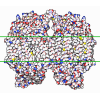[English] 日本語
 Yorodumi
Yorodumi- PDB-5gjv: Structure of the mammalian voltage-gated calcium channel Cav1.1 c... -
+ Open data
Open data
- Basic information
Basic information
| Entry | Database: PDB / ID: 5gjv | ||||||||||||
|---|---|---|---|---|---|---|---|---|---|---|---|---|---|
| Title | Structure of the mammalian voltage-gated calcium channel Cav1.1 complex at near atomic resolution | ||||||||||||
 Components Components |
| ||||||||||||
 Keywords Keywords | MEMBRANE PROTEIN / complex / channel | ||||||||||||
| Function / homology |  Function and homology information Function and homology informationhigh voltage-gated calcium channel activity / L-type voltage-gated calcium channel complex / positive regulation of muscle contraction / regulation of calcium ion transmembrane transport via high voltage-gated calcium channel / cellular response to caffeine / calcium ion import across plasma membrane / regulation of ryanodine-sensitive calcium-release channel activity / voltage-gated calcium channel activity / release of sequestered calcium ion into cytosol / T-tubule ...high voltage-gated calcium channel activity / L-type voltage-gated calcium channel complex / positive regulation of muscle contraction / regulation of calcium ion transmembrane transport via high voltage-gated calcium channel / cellular response to caffeine / calcium ion import across plasma membrane / regulation of ryanodine-sensitive calcium-release channel activity / voltage-gated calcium channel activity / release of sequestered calcium ion into cytosol / T-tubule / muscle contraction / calcium channel regulator activity / sarcolemma / calcium ion transmembrane transport / transmembrane transporter binding / calmodulin binding / metal ion binding / plasma membrane Similarity search - Function | ||||||||||||
| Biological species |  | ||||||||||||
| Method | ELECTRON MICROSCOPY / single particle reconstruction / cryo EM / Resolution: 3.6 Å | ||||||||||||
 Authors Authors | Wu, J.P. / Yan, Z. / Li, Z.Q. / Zhou, Q. / Yan, N. | ||||||||||||
| Funding support |  China, 2items China, 2items
| ||||||||||||
 Citation Citation |  Journal: Nature / Year: 2016 Journal: Nature / Year: 2016Title: Structure of the voltage-gated calcium channel Ca(v)1.1 at 3.6 Å resolution. Authors: Jianping Wu / Zhen Yan / Zhangqiang Li / Xingyang Qian / Shan Lu / Mengqiu Dong / Qiang Zhou / Nieng Yan /  Abstract: The voltage-gated calcium (Ca) channels convert membrane electrical signals to intracellular Ca-mediated events. Among the ten subtypes of Ca channel in mammals, Ca1.1 is specified for the excitation- ...The voltage-gated calcium (Ca) channels convert membrane electrical signals to intracellular Ca-mediated events. Among the ten subtypes of Ca channel in mammals, Ca1.1 is specified for the excitation-contraction coupling of skeletal muscles. Here we present the cryo-electron microscopy structure of the rabbit Ca1.1 complex at a nominal resolution of 3.6 Å. The inner gate of the ion-conducting α1-subunit is closed and all four voltage-sensing domains adopt an 'up' conformation, suggesting a potentially inactivated state. The extended extracellular loops of the pore domain, which are stabilized by multiple disulfide bonds, form a windowed dome above the selectivity filter. One side of the dome provides the docking site for the α2δ-1-subunit, while the other side may attract cations through its negative surface potential. The intracellular I-II and III-IV linker helices interact with the β-subunit and the carboxy-terminal domain of α1, respectively. Classification of the particles yielded two additional reconstructions that reveal pronounced displacement of β and adjacent elements in α1. The atomic model of the Ca1.1 complex establishes a foundation for mechanistic understanding of excitation-contraction coupling and provides a three-dimensional template for molecular interpretations of the functions and disease mechanisms of Ca and Na channels. | ||||||||||||
| History |
|
- Structure visualization
Structure visualization
| Movie |
 Movie viewer Movie viewer |
|---|---|
| Structure viewer | Molecule:  Molmil Molmil Jmol/JSmol Jmol/JSmol |
- Downloads & links
Downloads & links
- Download
Download
| PDBx/mmCIF format |  5gjv.cif.gz 5gjv.cif.gz | 585.5 KB | Display |  PDBx/mmCIF format PDBx/mmCIF format |
|---|---|---|---|---|
| PDB format |  pdb5gjv.ent.gz pdb5gjv.ent.gz | 457.8 KB | Display |  PDB format PDB format |
| PDBx/mmJSON format |  5gjv.json.gz 5gjv.json.gz | Tree view |  PDBx/mmJSON format PDBx/mmJSON format | |
| Others |  Other downloads Other downloads |
-Validation report
| Arichive directory |  https://data.pdbj.org/pub/pdb/validation_reports/gj/5gjv https://data.pdbj.org/pub/pdb/validation_reports/gj/5gjv ftp://data.pdbj.org/pub/pdb/validation_reports/gj/5gjv ftp://data.pdbj.org/pub/pdb/validation_reports/gj/5gjv | HTTPS FTP |
|---|
-Related structure data
| Related structure data |  9513MC  9514C  9515C  5gjwC M: map data used to model this data C: citing same article ( |
|---|---|
| Similar structure data |
- Links
Links
- Assembly
Assembly
| Deposited unit | 
|
|---|---|
| 1 |
|
- Components
Components
-Protein , 1 types, 1 molecules A
| #1: Protein | Mass: 212240.594 Da / Num. of mol.: 1 / Source method: isolated from a natural source / Source: (natural)  |
|---|
-Voltage-dependent L-type calcium channel subunit beta- ... , 2 types, 2 molecules BC
| #2: Protein | Mass: 11974.729 Da / Num. of mol.: 1 / Fragment: UNP residues 80-174 Source method: isolated from a genetically manipulated source Details: This domain was docked by a crystal structure (4DEY) Source: (gene. exp.)   |
|---|---|
| #3: Protein | Mass: 22356.846 Da / Num. of mol.: 1 / Fragment: UNP residues 265-463 Source method: isolated from a genetically manipulated source Details: This domain was docked by a crystal structure (4DEY) Source: (gene. exp.)   |
-Voltage-dependent calcium channel ... , 2 types, 2 molecules EF
| #4: Protein | Mass: 25082.254 Da / Num. of mol.: 1 / Source method: isolated from a natural source / Source: (natural)  |
|---|---|
| #5: Protein | Mass: 125156.000 Da / Num. of mol.: 1 / Source method: isolated from a natural source / Source: (natural)  |
-Sugars , 4 types, 15 molecules 
| #6: Polysaccharide | 2-acetamido-2-deoxy-beta-D-glucopyranose-(1-4)-2-acetamido-2-deoxy-beta-D-glucopyranose Source method: isolated from a genetically manipulated source #7: Polysaccharide | Source method: isolated from a genetically manipulated source #8: Polysaccharide | 2-acetamido-2-deoxy-beta-D-glucopyranose-(1-4)-2-acetamido-2-deoxy-beta-D-glucopyranose-(1-4)-2- ...2-acetamido-2-deoxy-beta-D-glucopyranose-(1-4)-2-acetamido-2-deoxy-beta-D-glucopyranose-(1-4)-2-acetamido-2-deoxy-beta-D-glucopyranose / triacetyl-beta-chitotriose | #9: Sugar | ChemComp-NAG / |
|---|
-Non-polymers , 2 types, 17 molecules 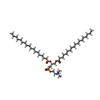


| #10: Chemical | ChemComp-PC1 / #11: Chemical | |
|---|
-Details
| Has protein modification | Y |
|---|---|
| Sequence details | RESIDUE F1075 IS DUE TO GPI MODIFICATI |
-Experimental details
-Experiment
| Experiment | Method: ELECTRON MICROSCOPY |
|---|---|
| EM experiment | Aggregation state: PARTICLE / 3D reconstruction method: single particle reconstruction |
- Sample preparation
Sample preparation
| Component | Name: voltage-gated calcium channel Cav1.1 / Type: COMPLEX Details: The protein complex was endogenous purified from rabbit muscle tissue. Entity ID: #1-#5 / Source: NATURAL |
|---|---|
| Molecular weight | Value: 0.5 MDa / Experimental value: NO |
| Source (natural) | Organism:  |
| Buffer solution | pH: 8 Details: 100 mM Tris-HCl, pH 8.0,200 mM NaCl, 10 mM CaCl2,15 mM reduced glutathione, 0.1% digitonin, and protease inhibitors. |
| Specimen | Conc.: 2 mg/ml / Embedding applied: NO / Shadowing applied: NO / Staining applied: NO / Vitrification applied: YES / Details: This sample was monodisperse. |
| Specimen support | Grid material: COPPER / Grid mesh size: 300 divisions/in. / Grid type: Quantifoil R1.2/1.3 |
| Vitrification | Instrument: FEI VITROBOT MARK IV / Cryogen name: ETHANE / Humidity: 100 % / Chamber temperature: 281 K Details: Grids were blotted for 2 s and flash-frozen in liquid ethane cooled by liquid nitrogen |
- Electron microscopy imaging
Electron microscopy imaging
| Experimental equipment |  Model: Titan Krios / Image courtesy: FEI Company |
|---|---|
| Microscopy | Model: FEI TITAN KRIOS |
| Electron gun | Electron source:  FIELD EMISSION GUN / Accelerating voltage: 300 kV / Illumination mode: SPOT SCAN FIELD EMISSION GUN / Accelerating voltage: 300 kV / Illumination mode: SPOT SCAN |
| Electron lens | Mode: BRIGHT FIELD / Calibrated defocus min: 1.3 nm / Calibrated defocus max: 2.9 nm / Alignment procedure: COMA FREE |
| Specimen holder | Cryogen: NITROGEN / Specimen holder model: FEI TITAN KRIOS AUTOGRID HOLDER / Temperature (min): 70 K |
| Image recording | Average exposure time: 8 sec. / Electron dose: 50 e/Å2 / Detector mode: SUPER-RESOLUTION / Film or detector model: GATAN K2 SUMMIT (4k x 4k) / Num. of grids imaged: 5 / Num. of real images: 9704 |
| Image scans | Movie frames/image: 32 |
- Processing
Processing
| EM software |
| ||||||||||||||||||||||||||||||||||||||||||||
|---|---|---|---|---|---|---|---|---|---|---|---|---|---|---|---|---|---|---|---|---|---|---|---|---|---|---|---|---|---|---|---|---|---|---|---|---|---|---|---|---|---|---|---|---|---|
| CTF correction | Type: PHASE FLIPPING AND AMPLITUDE CORRECTION | ||||||||||||||||||||||||||||||||||||||||||||
| Particle selection | Num. of particles selected: 1630270 | ||||||||||||||||||||||||||||||||||||||||||||
| Symmetry | Point symmetry: C1 (asymmetric) | ||||||||||||||||||||||||||||||||||||||||||||
| 3D reconstruction | Resolution: 3.6 Å / Resolution method: FSC 0.143 CUT-OFF / Num. of particles: 527833 / Symmetry type: POINT | ||||||||||||||||||||||||||||||||||||||||||||
| Atomic model building | Protocol: RIGID BODY FIT | ||||||||||||||||||||||||||||||||||||||||||||
| Refinement | Highest resolution: 3.6 Å |
 Movie
Movie Controller
Controller



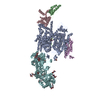
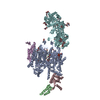
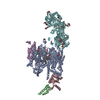

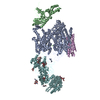

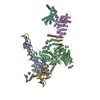

 PDBj
PDBj




